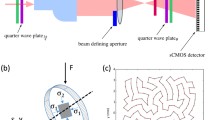Abstract
This paper describes an automatic measurement method for the stress analysis of a three-dirnensional photoelastic model having the rotation of the principal stress by scattered-light photoelasticity using unpolarized light. The relative phase retardation and the principal stress directions of a linear retarder for a distance in the solid model are expressed in terms of measurable Stokes parameters. The method was used for measurements on a frozen stress sphere under diametral compression.
Similar content being viewed by others
Abbreviations
- ρ:
-
relative phase retardation
- P Emphasis>/j i :
-
relative phase retardation at λi between the pointsy j andy j−1 in the model
- λi :
-
light wavelength
- ψ:
-
angle of one of the principal stress directions
- ψj :
-
angle of one of the principal stress directions between the pointsy j andy j−1 in the model
- E yj,θλi :
-
incident unpolarized light at λi along θ deg with thex-axis in thexz plane at the pointy j
- S(y j ;θ)λi :
-
Stokes vector of resultant scattered light ofE yj,θλi observed from they-axis, which is the linearly polarized light of azimuth θ measured from thez-axis in thexz plane
- M jλi :
-
Mueller matrix of linear retarder between pointsy j andy j−1 at λi
- U(y j ,y 0)λi :
-
Mueller matrix of the photoelastic model between pointsy j andy 0
- M j−1,1λi :
-
Mueller matrix of linear retarder with retardation p j-1,1 i , principal axes of azimuths ψ j-1,1 and ψ j-1,1 + σ/2 of optically equivalent model between pointsy j−1 andy 0
- R(ωj-1,1):
-
Mueller matrix of pure rottor with rotatory power ωj-1,1, of optically equivalent model between pointsy j−1 andy 0
- S(y j ,y 0;θ)λi :
-
Stokes vector of the light emerged through the medium between pointsy j andy 0 from the scattered lightS(y j ;θ)λi at pointy j
- s(y j ,y 0;θ)λi :
-
normalized Stokes vector ofS(y j ;y 0;θ)λi
- S 0(y j ;θ)λi :
-
intensity of the scattered lightS(y j ;θ)λi
- N :
-
integer
- T(θ,β2,α2):
-
light intensity emergin from analyzing system
- β2,α2 :
-
azimuth of the fast axis ofQ 2 and azimuth of the transmission axis ofP 2 of analyzing system, as measured fromz-axis, respectively
- Δρ i :
-
phase difference error ofQ 2 to λ i
References
Hurwitz, H. andJones, R.C., “A New Calculus for the Treatment of Optical Systems. II. Proof of Three General Equivalence Theorerns,”J. Opt. Soc. Am.,31,493–499 (1941).
Aben, H.K., “Optical Phenomena in Photoelastic Models by the Rotation of Principal Axes,” EXPERIMENTAL MECHANICS,6, (1),13–22 (1966).
Srinath, L.S. andSarma, A.V.S.S.S.R., “Determination of the Optically Equivalent Model in Three-dimensional Photoelasticity,” EXPERIMENTAL MECHANICS14 (3)118–122 (1974).
Robert, A., “New Methods in Photoelasticity,” EXPERIMENTAL MECHANICS,7 (5, 224–232 (1967).
Gross-Petersen, J.F., “A Scattered Light Method in Photoelasticity,” EXPERIMENTAL MECHANICS,14,317–322 (1974).
Theocaris, P.S. and Gdoutos, E.E., “On a Novel Matrix Method for Three-dimensional Photoelasticity,” Proc. 6th Int. Conf. Exp. Stress Analy., München, Germany, 599–605 (1978).
Kubo, H., Yamada, Y., Nagata, R. andHirose, T., “Automatic Measurement of a Few Simple Birefringent Distributions in an Anisotropic Medium by Using the Stokes Parameters,”Optik,72 (1),31–37 (1985).
Kihara, T., Kubo, H. andNagata, R. “Measurement of 3-D Stress Distribution by a Scatterred-light Method Using Depolarized Incident Light,”Appl. Opt.,18 (3)321–327 (1979).
Frocht, M.M. and Guernsey, R., Jr., “A Special Investigation to Develop a General Method for Three-dimensional Photoelastic Stress Analysis,” NACA Technical Note 2822 (1952).
Weller, R., “A New Method for Photoelasticity in Three Dimensions,”J. Appl. Phys.,10,266 (1939).
Frocht, M.M. and Srinath, L.S., “A Non-destructive Method for Three-dimensional Photoelasticity,” Proc. 3rd U.S. Nat. Congr. Appl. Mech., 329–337 (1958).
Voloshin, A.S. andBurger, C.P., “Half-fringe Photoelasticity: A New Approach to Whole-field Stress Analysis,” EXPERIMENTAL MECHANICS,23 (9),304–313 (1983).
Hecker, F.W. and Abeln, H., “Digital Phase-shifting Photoelasticity,” Proc. 14th Congr. Int. Commission for Optics, Quebec, Canada, 97–98 (1987).
Kihara, T., “Automatic Whole-field Measurement of Photoelasticity Using Linearly Polarized Light,” Proc. 9th Int. Conf. on Experimental Mechanics, Copenhagen, 821–827 (1990).
Kihara, T., “Automatic Whole-field Measurement of Principal Stress Directions using Three Wavelengths,” Proc. 10th Int. Conf. on Experimental Mechanics, Lisbon, 95–99 (1994).
Theocaris, P.S. andGdoutos, E.E., Matrix Theory of Photoelasticity, Springer-Verlag, New York (1979).
Kubo, H., “Photoelastic Studies of Automatic and Nondestructive Method by Measuring the Stokes Parameters. III. Numerical Simulation by Using Two-beams Incident Method” (in Japanese),Proc. 14th Symposium on Photoelasticity, The Japan Society for Photoelasticity,14,41–44, (1992).
Author information
Authors and Affiliations
Rights and permissions
About this article
Cite this article
Kihara, T. A measurement method of scattered light photoelasticity using unpolarized light. Experimental Mechanics 37, 39–44 (1997). https://doi.org/10.1007/BF02328748
Issue Date:
DOI: https://doi.org/10.1007/BF02328748




